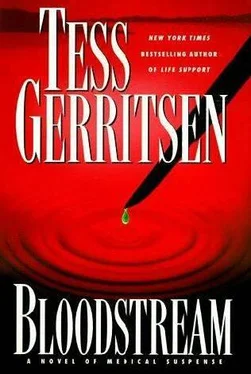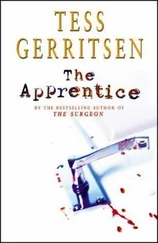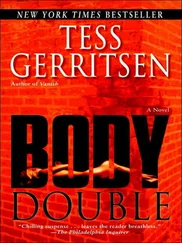They had only a bare-bones surgical team waiting in the trauma room, but it was the best McNally could round up on such short notice: an anesthetist, two obstetrical nurses, and Dr. Byrne, a general surgeon.
At once Byrne moved into action. With a scalpel, he slashed the skin above Kitty’s rib and with almost savage force shoved in a plastic chest tube. Blood gushed through the tube and poured into the glass reservoir. He took one look at the rapidly accumulating blood and said, “We have to crack the chest.”
They had no time for the ritual hand scrub. While McNally performed a cutdown on the girl’s arm for another IV line, and a unit of O-neg blood pumped in, Claire slipped into a surgical gown, thrust her hands into sterile gloves, and took her place across from Byrne. She could see from his white face that he was scared.
He was not a thoracic surgeon, and clearly he knew he was in over his head. But Kitty was dying, and there was no one else to turn to.
“Hail Mary, full of grace,” he muttered, and started up the sternal saw.
Wincing at the whine of the saw, Claire squinted against the spray of bone dust, into the widening gap of Kitty’s chest cavity. All she could see was blood, glistening like red satin under the lights. A massive hemothorax. As Byrne positioned the retractors, widening the gap, Claire suctioned, temporarily clearing the cavity “Where’s it coming from?” muttered Byrne. “The heart looks undamaged.”
And so small, thought Claire with sudden anguish. This child is so very small…
“We’ve got to clear away this blood.”
As Claire suctioned deeper, a tiny spurt suddenly appeared from the lacerated lung, pumping out an arc of blood.
“I see it,” he said, and snapped on a clamp.
Another spurt appeared, fresh blood swirling bright red into the darker pool.
“That’s two,” he said with a tense note of triumph, clamping off the second bleeder.
“I’m hearing a BP!” said a nurse. “Systolic’s seventy!” “Hanging the second unit of 0-neg.”
“There,” said Claire, and Byrne clamped off the third telltale spurt. Claire suctioned again. For a moment they watched the open chest, waiting in dread for the blood to reaccumulate. Everyone in the room fell silent. The seconds ticked by.
Then Byrne glanced across at her. “You know that Hail Mary I just said?”
“Yes?”
“It seems to be working.”
Pete Sparks was waiting for her when Claire finally emerged from the trauma room. Her clothes were splattered with blood, but he didn’t seem to notice it; they had seen so much violence that night, perhaps they could no longer be shocked by the sight of gore. “How’s the girl?” he asked.
“She made it through surgery As soon as her blood pressure’s stabilized, they’ll be transferring her to Bangor.” Claire gave him a tired smile. “I think she’ll be fine, Pete.”
“We brought the boy here,” he said.
“Scotty?”
He nodded. “The nurses put him in that exam room over there. Lincoln thought you’d better take a look at him. There’s something wrong.”
With growing apprehension, she crossed the ER and came to an abrupt halt in the exam room doorway. There she stood staring into the room, saying nothing, a chill rising up her spine.
She almost jumped when Pete said, quietly, “You see what I mean?” “What about his mother?” she asked. “Did you find Faye?” “Yes, we found her.”
“Where?”
“In the cellar. She was still in her wheelchair.” Pete looked into the exam room, and as if repelled by what he saw, he took a fearful step backwards. “Her neck was broken. He pushed her down the stairs.”
From the other side of the X-ray viewing window, Claire and the CT technician watched Scotty Braxton’s head disappear into the mouth of the scanner. His limbs and chest were firmly strapped to the table, but his hands continued to twist against the leather restraints and his wrists had already been chafed raw, streaking the leather with blood.
“We’re not going to get any decent shots,” said the tech. “Still too much movement. Maybe you can give him some more Valium?”
“He’s already got five milligrams on board. I hate to obscure his neuro status,” said Claire.
“It’s either that or no CT.”
She had no choice. She filled the syringe and entered the scan room. Through the window, she saw the state trooper watching her. She approached the table and reached for the IV port. Without warning the boy’s hand shot open. She jerked away just as his fingers clamped down like a trap.
The cop stepped into the room. “Dr. Elliot?”
“I’m okay,” she said, heart pounding. “He just startled me.”
“I’m right here. Go ahead and give him the medicine.”
Quickly she snatched up the IV line, plunged the needle in the rubber dam, and injected the full two milligrams.
The boy’s hand finally fell still.
From behind the window, she watched as the scanner began to whir and click, bombarding his head with a shifting sequence of X-ray beams. The first slice, from the top of the cranium, appeared on the computer screen.
“Looks normal so far,” said the tech. “What are you expecting to see?”
“Any anatomical abnormality that might explain his behavior. A mass, a tumor.
There has to be a reason for this. He’s the second boy I’ve seen with uncontrollable aggression.”
They all turned as Lincoln came into the CT room. The tragedy had taken its toll on him; she could see it in his face, in the shadows under his eyes and the sadness of his gaze. For him, the death of Faye Braxton had been only the start of an endless night of press conferences and meetings with state police investigators. He shut the door and seemed to breathe a sigh of relief that he had at last found a quiet, albeit temporary, retreat.
He crossed to the window and gazed at the boy lying on the table. “What have you found so far?”
“The preliminary drug screens were just called back from Bangor. His blood’s negative for amphetamines, phencyclidine, and cocaine. The usual drugs associated with violence. Now we have to rule out other causes for his behavior.” She looked through the glass at her patient. “It’s just like Taylor Darnell. And this boy has never been on Ritalin.”
“Are you sure?”
“I’m their family doctor. I have all Scotty’s records from Dr. Pomeroy’s files.”
They both stood with shoulders propped wearily against the window, conserving energy for the hours that lay ahead. It was the only time they ever seemed to interact, she realized. When they were both tired or scared or distracted by crisis. Neither one of them looking his best. They held no illusions about each other, because they had been through the worst together. And I’ve only learned to admire him more, she thought with surprise.
The tech said, “Here come the final cuts.”
Both Claire and Lincoln stirred from their exhausted daze and crossed to the computer terminal. She sat down to watch as the cross sections of brain appeared on the screen. Lincoln moved behind her, his hands resting on the back of her chair, his breath warming her hair.
“So what do you see?” asked Lincoln.
“No midline shift,” she said. “No masses. No bleeding.”
“How can you tell what you’re looking at?”
“The whiter it is, the denser it is. Bone is white, air is black. As you cut lower in the cranium, you’ll begin to see parts of the sphenoid bone appearing, at the base of the brain. What I’m looking for is symmetry Since most pathology affects only one side of the brain, I check for differences between the two sides.”
A new cut appeared. Lincoln said, “That view doesn’t look symmetrical to me.”
Читать дальше
Конец ознакомительного отрывка
Купить книгу












